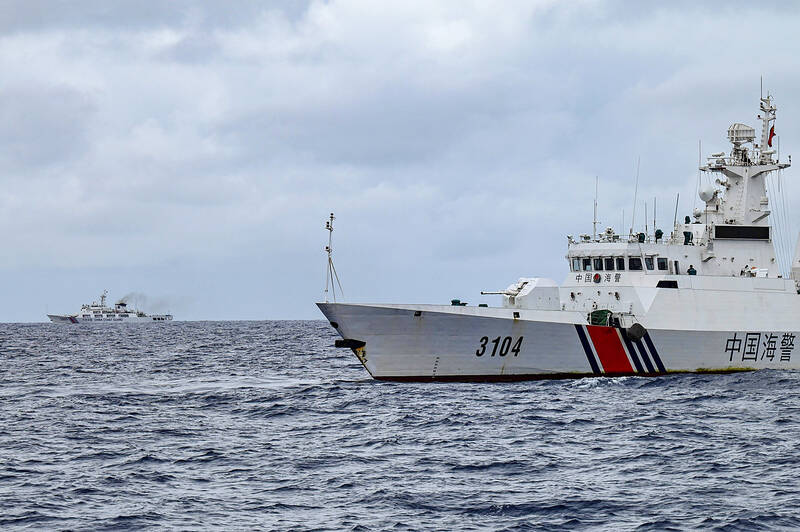China’s attempts at expanding into waters around Taiwan are facing international pushback, the National Security Bureau (NSB) said.
Beijing’s expansion into the Taiwan Strait, and East China and South China seas has triggered international countermeasures, the NSB said in a report to the Legislative Yuan.
The US and China have not changed their strategic rivalry, it said. The US is closely monitoring China’s coercive “gray zone” tactics in the Indo-Pacific region and expressed support for maintaining the “status quo” in the Taiwan Strait. Meanwhile, China maintains its position on Taiwan, emphasizing its right to enforce its laws in the South China Sea, and has attempted to exclude the US in the ongoing issue according to the Declaration on the Conduct of Parties in the South China Sea agreement.

Photo: AFP
As a way to counter the US’ containment strategy, China has also suspended arms control and arms proliferation consultations with the US, the NSB added.
Chinese President Xi Jinping (習近平) has tried to prepare his party and armed forces for military conflict at sea, and promote the construction of “modern” sea and air border defenses, the report said.
China has also expanded its jurisdiction in the region through laws such as China Coast Guard Regulation No. 3, which allows the coast guard to board and hold vessels in disputed waters it claims, as well as augmenting its patrols and surveillance at sea, the NSB said.
In the area around the Taiwan Strait, the Chinese People’s Liberation Army (PLA) has renovated coastal airports and used military exercises to demonstrate the integration of its maritime policing and military capabilities and put pressure on Taiwan, it said.
The PLA has frequently crossed into the restricted waters around Taiwan’s outlying islands with military, non-military and dual-use vessels, and has even sent small speedboats to Linkou (林口) and Tamsui (淡水), expanding the potential area of “gray zone” tactics and further harassing Taiwan, the report said.
In the East China Sea, the PLA recently sent four armed vessels to the Diaoyutai Islands (釣魚台) — also known as the Senkakus in Japan — in addition to its patrols around Japan’s Ryukyu Islands and sending an intelligence-gathering plane in Japan’s airspace for the first time in August, it said.
In the South China Sea, the PLA held joint naval exercises with the Russian navy for the first time in eight years and has made controversial actions such as ramming Philippine Coast Guard vessels, it added.
In response, the US and its allies have frequently highlighted the importance of peace and stability in the Taiwan Strait and have opposed China’s provocations, the report said.
The US has made Japan the centerpiece of its Indo-Pacific strategy through the recently upgraded US unified command in Japan, its attempts to bring Japan closer to the Philippines and Australia, the AUKUS security alliance and the Quad — consisting of Australia, Japan, India and the US, the NSB said.
European countries are also increasingly expressing their concerns about the stability and peace in the region by making more frequent transits through the Taiwan Strait and their participation in joint military training exercises, it added.

An essay competition jointly organized by a local writing society and a publisher affiliated with the Chinese Communist Party (CCP) might have contravened the Act Governing Relations Between the People of the Taiwan Area and the Mainland Area (臺灣地區與大陸地區人民關係條例), the Mainland Affairs Council (MAC) said on Thursday. “In this case, the partner organization is clearly an agency under the CCP’s Fujian Provincial Committee,” MAC Deputy Minister and spokesperson Liang Wen-chieh (梁文傑) said at a news briefing in Taipei. “It also involves bringing Taiwanese students to China with all-expenses-paid arrangements to attend award ceremonies and camps,” Liang said. Those two “characteristics” are typically sufficient

A magnitude 5.9 earthquake that struck about 33km off the coast of Hualien City was the "main shock" in a series of quakes in the area, with aftershocks expected over the next three days, the Central Weather Administration (CWA) said yesterday. Prior to the magnitude 5.9 quake shaking most of Taiwan at 6:53pm yesterday, six other earthquakes stronger than a magnitude of 4, starting with a magnitude 5.5 quake at 6:09pm, occurred in the area. CWA Seismological Center Director Wu Chien-fu (吳健富) confirmed that the quakes were all part of the same series and that the magnitude 5.5 temblor was

The brilliant blue waters, thick foliage and bucolic atmosphere on this seemingly idyllic archipelago deep in the Pacific Ocean belie the key role it now plays in a titanic geopolitical struggle. Palau is again on the front line as China, and the US and its allies prepare their forces in an intensifying contest for control over the Asia-Pacific region. The democratic nation of just 17,000 people hosts US-controlled airstrips and soon-to-be-completed radar installations that the US military describes as “critical” to monitoring vast swathes of water and airspace. It is also a key piece of the second island chain, a string of

The Central Weather Administration has issued a heat alert for southeastern Taiwan, warning of temperatures as high as 36°C today, while alerting some coastal areas of strong winds later in the day. Kaohsiung’s Neimen District (內門) and Pingtung County’s Neipu Township (內埔) are under an orange heat alert, which warns of temperatures as high as 36°C for three consecutive days, the CWA said, citing southwest winds. The heat would also extend to Tainan’s Nansi (楠西) and Yujing (玉井) districts, as well as Pingtung’s Gaoshu (高樹), Yanpu (鹽埔) and Majia (瑪家) townships, it said, forecasting highs of up to 36°C in those areas